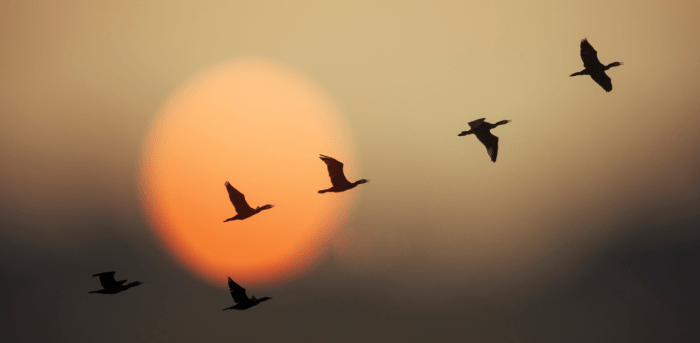At this time, migratory birds are setting off on their autumn journeys, which they do so every year with little deviation. They must determine the optimal time to travel and rely on their set of instinctual skills to get them to their destination. They must make choices which balance the gathering of sufficient food stocks and the upcoming weather conditions to ensure their survival.
Which factors then determine the onset of autumn migration?
- Light: The gradual reduction in light hours and the shallower sun angle lets birds know which part of the season is occurring.
- Temperature and Climate: Birds feel the progressive, subtle cooling of the temperature and in monsoonal areas, they feel the rainy season coming to a close.
- Food sources: As the summer and growing season winds up, birds will notice the drop in the abundance of their favourite food.
- Maturity of young: When the offspring that have grown up in the summer breeding grounds are of a certain age and size, adults will know that it may be time to migrate.
- Location-based: Depending on where birds live out their nomadic lives will determine when they begin their migration. Birds that summer in the very cold northern latitudes may depart as early as July – while others may not leave until September.
Once they’ve decided to head off, how do they find their way to their destination? Although the whole set of navigational skills is not completely understood, we know some of the techniques birds use.
- Consistent Flyways: The inherited learnings from veteran migrators who have taken the same course year-on-year is only part of the answer. Many birds however, have too short a lifespan and some species take circular routes. Incredibly, many young birds make their first migration alone.
- Food Trails: Some birds, like waterfowl and cranes, do follow the same route each year, stopping at places with important food sources. Many shorebirds will follow the coastlines and descend on the same stretch of beach every year in great numbers.
- Solar & Magnetic Cues: Birds use the sun and stars as a compass. The setting sun on certain landmarks can be used as a reference point. They can also sense the magnetic fields of the Earth and use these as guiding pathways.
- Smell: Found most notably in homing pigeons, who can locate where they’ve come from by developing an ‘olfactory map’, even in unfamiliar territory. One study found that their sense of smell can extend up to 200km!
Unfortunately, there are a great many interferences now in bird migration. From the chaos of climate change affecting food source timing and availability; development over important landing sites along the flyway food trails; habitat destruction at their breeding and non-breeding grounds; to navigational interference by electromagnetic radiation towers.
Those very risky choices migratory birds have to make each season are becoming much more difficult and their necessary resources – far less reliable.

